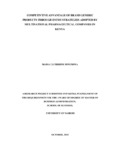| dc.description.abstract | The main purpose of the study was to determine if entry strategies influence competitive advantage of Pharmaceutical MNC in Kenya in light of the patent cliff. The study adopted cross-sectional study focusing on the Pharmaceutical MNC industry with brand products in the market. The population of interest is the big pharmaceutical multinational companies in Kenya with block-buster medicines going off patent. The Kenyan Pharmaceutical sector has about 30 licensed units of pharmaceutical manufacturing companies. Out of which, there were pharmaceutical MNC with a local technical representative office (LTRO) whose main aim was to ensure brand presence in the region. The Pharmaceutical MNC in Nairobi form a population of 15 companies selected. The target respondents were the Country manager, Regional Business Development manager and the Marketing Director or Manager in the Company. The study used primary and secondary data collection through open ended and structured questionnaires. Data collected was coded and entered into the Statistical Package for Social Sciences for analysis (SPSS). The findings were presented in pie charts, frequency tables, bar graphs were used to present the data collected for ease of understanding. The study established that Competitive strategies are critical factors on entry strategies adopted by pharmaceutical firms. The study shows that in companies where product advantages provide very strong competition there was increased marketing. With competitive advantage in place, entry strategies ensure that the pharmaceutical firms are able to give quality output, increased quantity production, customers’ satisfaction and amount of sales brought. The findings on the strategies used by pharmaceutical to enter into the Kenyan market established that most of the pharmaceutical companies allow other companies to use their brands in marketing their products through licensing arrangement, followed by the pharmaceutical companies are using technology to manufacture products to ensure that they are of high quality to match customer specifications, the products are easily available, and the products are affordable. The least utilized marketing strategy included the distribution of pharmaceutical products handled by an agent or distributor. The key challenges faced by pharmaceutical companies included poor infrastructural development driving up operational costs, rules on taxation were not fair, customers still relied on traditional medicine practices and there is a poor legal infrastructure. The least challenge was on the instability of the local currency leading to losses or uncompetitive pricing, huge investment outlay in buying state of the art technology for manufacturing pharmaceutical products, strong customer loyalty from multinational pharmaceutical companies and the government is reluctant to develop and enforce laws protecting intellectual property rights. The study recommends that pharmaceutical MNCs should engage with emerging markets more closely and that planning of loss of exclusivity should be an ongoing product lifecycle strategy initiated at the launch of the product up until loss of exclusivity. | en_US |

